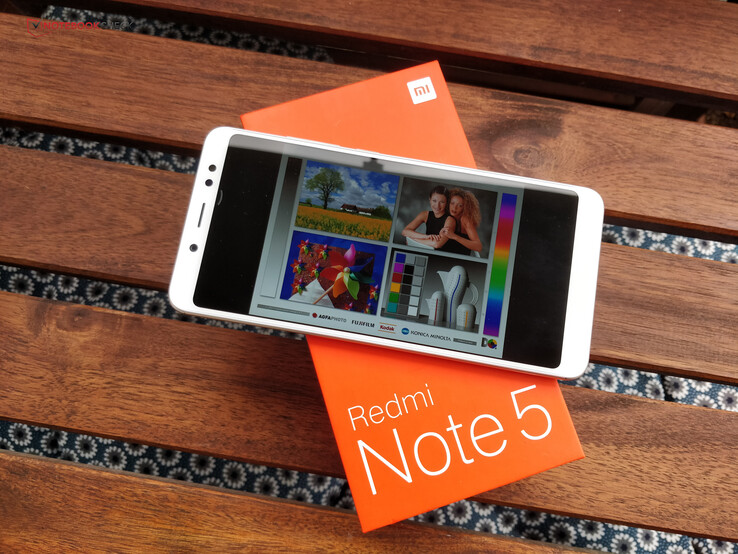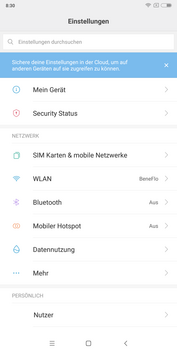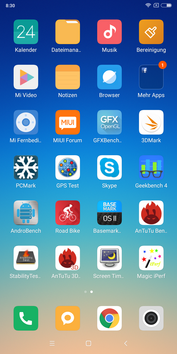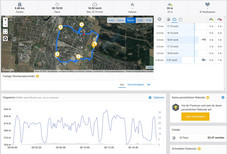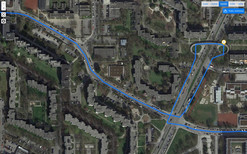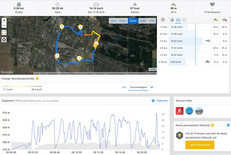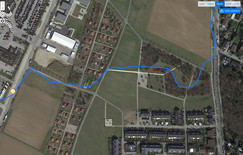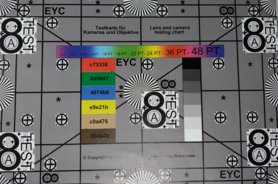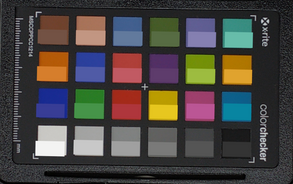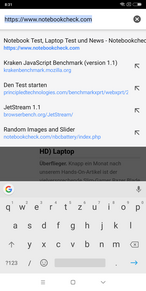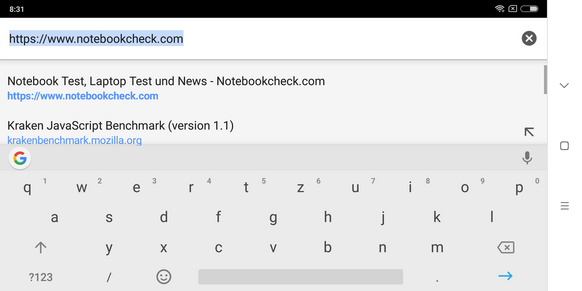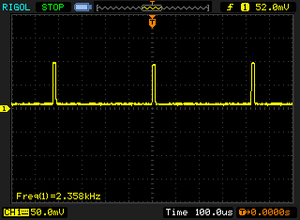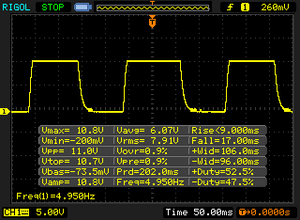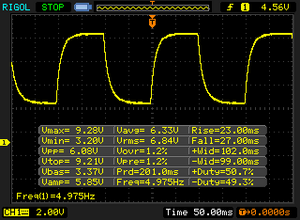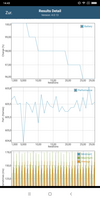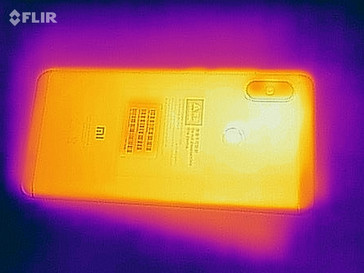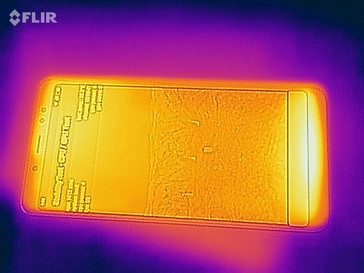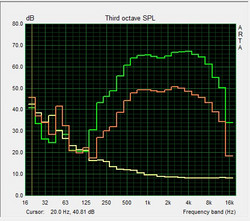Xiaomi Redmi Note 5 Smartphone Review
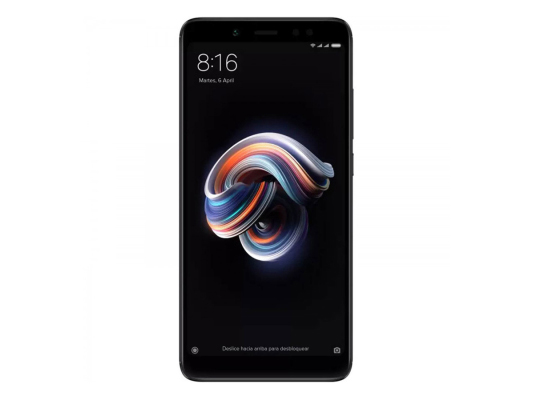
Xiaomi smartphones are becoming increasingly more popular in Europe, particularly the Redmi series. Redmi devices have always combined good quality at a reasonable price. The Note 5 is a phablet with a 5.99-inch display, a mid-range SoC, fast Wi-Fi and a dual-camera all for under €240 (~$277).
For reference, our review unit is the M1803E7SG. This is also known as the Redmi Note 5 AI Dual Camera. It is neither the Redmi 5 Plus, which is listed as the Redmi Note 5 on Xiaomi's Mi website, nor is it the Redmi Note 5 Pro either. All three devices are powered by a Qualcomm Snapdragon 636 SoC, but they feature different camera hardware and memory options among other differences.
We have chosen to compare the Note 5 against the Motorola Moto G6 Plus, the Huawei Y7 2018, the Maze Alpha X and the Honor 7X. Find out in this review how the Note 5 compares with similarly priced competitors and whether it continues the Redmi series ethos.
Case
The Note 5 is available in Lake Blue, Black, Gold and Rose Gold. Our test device is the Rose Gold variant, which has a white front. The Note 5 has a metal case, which proved to be stable during our tests. Our test device did not react to pressure applied to the back of the case, while light pressure on the display causes slight waves in the LCD. Our test device withstood our attempts to bend and twist it, with hardly any creaks or cracking noises when doing so.
The design is not exceptional, but it is stylish. The metal back is sandwiched between color matching plastic areas designed to improve the reception quality. The display is flush with the case but for a slight edge. This is deliberate though and is a relatively smooth edge. The Note 5 weighs 180 g (~6.3 oz) and measures 158.5 x 75.4 x 8.1 mm (~6.2 x ~3 x ~0.32 in). This weight and dimension help the device to feel good in the hand. The rear-facing camera array protrudes slightly from the case, so the Note 5 is slightly unstable on flat surfaces.
Connectivity
Our test device has 3 GB of RAM and 32 GB of internal storage. There is also a 64 GB/4 GB option, which we would recommend over our test device as they are currently equally priced online. The Note 5 is a Dual-SIM device and supports microSD cards up to 256 GB. MicroSD cards can only be formatted as external storage, which means that app data can only be stored on the 32 GB of internal storage. Incidentally, the card tray has only two slots, so you can either use two nano-SIMs or one SIM and a microSD card.
The Note 5 features an FM radio, Bluetooth 5.0 and a fingerprint sensor. There is even an IR remote that can be used as a remote control. Unfortunately, there is only a microUSB port instead of a USB Type-C port. The microUSB port is only USB 2.0, albeit this supports USB OTG.
Software
The Note 5 ships with Android Oreo 8.1, which has been customized with Xiaomi’s MIUI. Our test device is running MIUI Global 9.5 and Android security patch level March 1st 2018, which was about six weeks old at the time of writing. MIUI looks different than the UI on many other Android smartphones, with Xiaomi implementing numerous changes from stock Android. MIUI should not take Android users too much time to adapt though. Frustratingly, we could not change the screen timeout as the button to confirm the change is missing. Equally frustrating is the energy-saving features, which are overly restrictive. Runtastic, for example, ran correctly only after changing numerous settings.
The Note 5 comes with many additional apps, most of which are by Xiaomi. Fortunately, there is little bloatware except for one social network app.
Communication & GPS
The Note 5 is equipped with fast IEEE 802.11 ac Wi-Fi, which is rare for a €240 (~$277) device and one that will make many users happy. While the Note 5 cannot match the Motorola G6 Plus in terms of Wi-Fi performance, the Note 5 is faster than all our other comparison devices. We calculated this performance using our Linksys EA8500 reference router. Our test device loaded websites quickly when we were close to the router, but we did have to wait for some images to load. The Note 5 still had full Wi-Fi reception when we took the device around ten meters (~33 ft) away from the router with three walls between the two devices. Websites loaded just as fast as they do when we tested the Note 5 with it close to our reference router.
The Note 5 supports seven LTE bands, which is rather paltry in comparison to other devices. In practice, this means that you may struggle with connecting to an LTE network in more exotic countries. Our test device had good mobile network reception on the German D2 network. We still had good reception even in buildings in built-up areas.
| Networking | |
| iperf3 transmit AX12 | |
| Motorola Moto G6 Plus | |
| Xiaomi Redmi Note 5 | |
| Maze Alpha X | |
| Huawei Y7 2018 | |
| Huawei Honor 7X | |
| iperf3 receive AX12 | |
| Motorola Moto G6 Plus | |
| Xiaomi Redmi Note 5 | |
| Maze Alpha X | |
| Huawei Y7 2018 | |
| Huawei Honor 7X | |
The Note 5 struggled to locate us when indoors. Although there is a satellite signal, it cannot locate us. Things improved when we moved to a window, where the Note 5 located us to an accuracy of nine meters (~30 ft). Location accuracy drastically improves outdoors though, with our test device being accurate to three meters (~10 ft). This is an impressive location accuracy given the Note 5’s price. The Note 5 has a compass, which quickly indicates our direction in Google Maps.
We took the Note 5 on a bike ride to test its location accuracy against a professional navigation device, the Garmin Edge 520. Our test device performed well, but it is far more inaccurate than the Garmin. The Note 5 deviated by 120 m (~394 ft) from the Garmin, which represents a 97.8% accuracy compared to the professional navigation device. The Huawei Y7 (2018) has better location accuracy than the Note 5, but the latter should be suitable for all general navigation tasks.
Phone Functions & Call Quality
The Note 5 uses Xiaomi’s phone app, which is much like Google’s standard phone app. Launching the app brings up the keypad and a list of recent calls. There is a small search window in which you can search directly for contacts. Alternatively, you bring up your contact list by clicking the contacts tab. The phone app has numerous settings such as a phone number blacklist and call recording among other features.
The Note 5 has good call quality. Our call partner sounded clear and without any background noise. Our test device reproduced our voice well, but the microphone distorted if we spoke too loudly. The opposite is true over the speakerphone, where the microphone struggled to pick out our voice if we spoke softly. Our counterpart is still easy to understand, albeit there is some mild background noise during quieter moments.
Cameras
The Note 5 has dual rear-facing cameras, one 12 MP and one 5 MP. The secondary camera is only used to help create depth of field bokeh effect photographs and it cannot be used as a standalone camera. Photos taken with the main camera have fewer details than those taken with more premium smartphones, with some areas coming out particularly muddy and lacking definition. Our test device gets the exposure right in dark areas in good lighting and there is even some detail in very bright areas. Low-light performance is surprisingly good, but there is a clear blue tint to the photos. The Apple iPhone X captures night shots more accurately, but the latter costs practically five times as much as the Note 5. Overall, the Note 5 has an impressive rear-facing camera array given its price.
The main camera can record videos in up to 1080p at 30 FPS. The video quality is passable, although bright areas are often underexposed, while dark areas lack detail. Recordings are sharp though. There is a 120 FPS slow motion feature, which is recorded at 720p.
The Note 5 has a 13 MP front-facing camera, which in theory could make the Note 5 a selfie star. While the Note 5 does well for a more affordable device, it does not come close to more premium smartphones. Dark areas are exposed well, but bright areas often dominate a photograph. Sharpness is rather average too, but the front-facing camera reproduces colors well.
The Note 5 does not fare much better under controlled lighting conditions either. Sharpness is passable, with our test device reproducing text against a colored background well. Transitions between colors appear pixelated, but this is still ok for a device at this price. Generally, images are overly dark, particularly color reproduction.
Accessories & Warranty
The Note 5 comes with a quick charger, a USB cable, a SIM tool and a protective cover. Xiaomi does not offer any dedicated accessories on its website.
The Note 5 does not come with a manufacturer’s warranty in Europe seeing as Xiaomi are a Chinese company. You will get twenty-four months warranty if you buy through an EU supplier though. Please see our Guarantees, Return policies and Warranties FAQ for country-specific information.
Input Devices & Operation
Xiaomi has installed Google GBoard as the Note 5’s default keyboard. Other keyboards are available from the Google Play Store.
The Note 5 has a touchscreen that has a slick, smooth surface. Touch inputs are precise even at the corners and at the edges of the display. There is a fingerprint sensor on the back of the device that quickly and reliably unlocks our test device. The fingerprint sensor does not have any special gestures or configurable commands like we have seen on other devices, such as the ASUS ZenFone 4 Selfie Pro. There is a software-based quick ball which displays selected links when you click on them. This feature is less functional than using the standard on-screen navigation buttons though. Whereas opening a link with the quick ball takes a total of two clicks, using the standard navigation buttons takes just one click. A supplementary input method should increase functionality and ease of use in our opinion, rather than further complicate matters.
The hardware buttons can be found on the right-hand side of the case. These feel premium, are easy to use and have a clear pressure point.
Display
The Note 5 has a 5.99-inch display with a 2:1 aspect ratio. The display has a 2,160x1,080 native resolution, which results in a pixel density of 403 PPI. Our test device has an impressively bright display, which averaged 532.2 cd/m² using X-Rite i1Pro 2. Only the Motorola Moto G6 Plus has a brighter display of our comparison devices, with the Honor 7X scoring just slightly lower than the Note 5. The Moto G6 Plus is an outlier in this respect though with its 723 cd/m² average maximum luminosity. This is incredibly bright for a device at this price. The Note 5 has 94% display uniformity too, which is at least 4% better than the best of our comparison devices. In practical terms, this means that the large areas of color look uniformly bright. It is worth pointing out that we achieved this level of luminosity with the device on charge and with the brightness sensor turned off. Measuring our test device either on battery or with the brightness sensor turned on results in a lower average maximum brightness value.
| |||||||||||||||||||||||||
Brightness Distribution: 94 %
Center on Battery: 448 cd/m²
Contrast: 2252:1 (Black: 0.23 cd/m²)
ΔE ColorChecker Calman: 5.66 | ∀{0.5-29.43 Ø4.78}
ΔE Greyscale Calman: 6.8 | ∀{0.09-98 Ø5}
99.7% sRGB (Calman 2D)
Gamma: 2.269
CCT: 8564 K
| Xiaomi Redmi Note 5 IPS, 2160x1080, 6" | Maze Alpha X IPS, 2160x1080, 6" | Motorola Moto G6 Plus IPS, 2160x1080, 5.9" | Huawei Honor 7X IPS, 2160x1080, 5.9" | Huawei Y7 2018 IPS, 1440x720, 6" | |
|---|---|---|---|---|---|
| Screen | -70% | 1% | 5% | -9% | |
| Brightness middle (cd/m²) | 518 | 497 -4% | 761 47% | 533.2 3% | 393 -24% |
| Brightness (cd/m²) | 532 | 478 -10% | 723 36% | 511 -4% | 365 -31% |
| Brightness Distribution (%) | 94 | 87 -7% | 90 -4% | 88 -6% | 85 -10% |
| Black Level * (cd/m²) | 0.23 | 0.6 -161% | 0.69 -200% | 0.35 -52% | 0.29 -26% |
| Contrast (:1) | 2252 | 828 -63% | 1103 -51% | 1523 -32% | 1355 -40% |
| Colorchecker dE 2000 * | 5.66 | 11.6 -105% | 2.4 58% | 2.83 50% | 5.28 7% |
| Colorchecker dE 2000 max. * | 10.32 | 22.1 -114% | 5.2 50% | 6.72 35% | 9 13% |
| Greyscale dE 2000 * | 6.8 | 13.5 -99% | 1.8 74% | 3.7 46% | 4.2 38% |
| Gamma | 2.269 97% | 2.93 75% | 2.21 100% | 1.9 116% | 2.6 85% |
| CCT | 8564 76% | 9955 65% | 6312 103% | 6918 94% | 7086 92% |
* ... smaller is better
Screen Flickering / PWM (Pulse-Width Modulation)
| Screen flickering / PWM detected | 2358 Hz | ≤ 20 % brightness setting | |
The display backlight flickers at 2358 Hz (worst case, e.g., utilizing PWM) Flickering detected at a brightness setting of 20 % and below. There should be no flickering or PWM above this brightness setting. The frequency of 2358 Hz is quite high, so most users sensitive to PWM should not notice any flickering. In comparison: 53 % of all tested devices do not use PWM to dim the display. If PWM was detected, an average of 8149 (minimum: 5 - maximum: 343500) Hz was measured. | |||
The Note 5 has a 0.23 cd/m² black value that is both notably good and significantly better than our comparison devices. This low black value helps our test device achieve a laudable 2,252:1 contrast ratio that is leagues ahead of our comparison devices. This helps make colors pop and gives black tones a rich quality to them.
We subjected our test device to our spectrophotometer and CalMAN software to get a more detailed look at the display. The results highlight a significant blue tint to the display, which results in light blue and orange tones looking noticeably different than the sRGB reference color. The color space coverage is good overall, but the blue tint is one downside.
Unfortunately, the Note 5 uses pulse-width modulation (PWM) to regulate luminosity at and below 20% brightness. We notice a flicker to the display when the brightness is at this level, which we measured at 2,358 Hz. This frequency should be high enough for those who are PWM sensitive not to feel any ill effects, although this cannot be guaranteed.
Display Response Times
| ↔ Response Time Black to White | ||
|---|---|---|
| 26 ms ... rise ↗ and fall ↘ combined | ↗ 9 ms rise | |
| ↘ 17 ms fall | ||
| The screen shows relatively slow response rates in our tests and may be too slow for gamers. In comparison, all tested devices range from 0.1 (minimum) to 240 (maximum) ms. » 61 % of all devices are better. This means that the measured response time is worse than the average of all tested devices (20.3 ms). | ||
| ↔ Response Time 50% Grey to 80% Grey | ||
| 50 ms ... rise ↗ and fall ↘ combined | ↗ 23 ms rise | |
| ↘ 27 ms fall | ||
| The screen shows slow response rates in our tests and will be unsatisfactory for gamers. In comparison, all tested devices range from 0.165 (minimum) to 636 (maximum) ms. » 85 % of all devices are better. This means that the measured response time is worse than the average of all tested devices (31.7 ms). | ||
The Note 5 has a relatively bright display, which helps when using the device outdoors. We could still see screen content with brightness set to maximum if we were not in too bright an area. The display has a glossy finish though, so reflections cannot be avoided.
The Note 5 has an IPS display, which helps to give the device strong viewing angles. There are slight brightness and color shifts at acute viewing angles, but these are picked up more by the camera than they are noticeable by the naked eye.
Performance
The Note 5 is powered by a Qualcomm Snapdragon 636 SoC, a mid-range SoC that Qualcomm announced late last year. The Snapdragon 636 has an octa-core Kyro 260 CPU that clocks up to 1.8 GHz. The Snapdragon 636 is a significant improvement on its predecessor, the Snapdragon 630 that powers the Moto G6 Plus. The Snapdragon 636 helps the Note 5 to typically perform around 20% faster than the G6 Plus in benchmarks. Equally, the Note 5 feels snappy in practice, with our test device not slowing down even when we have numerous programs open in the background.
The Snapdragon 636 integrates a Qualcomm Adreno 509 GPU that supports DirectX 12.1, OpenGL ES 3.2, OpenCL 2.0 and Direct3D 12. This support for modern graphics APIs should ensure that the Note 5 is future proofed at least in terms of graphics. While the Note 5 has faster GPU performance than our comparison devices too, the gap is not as great as in our CPU tests.
| AnTuTu v6 - Total Score (sort by value) | |
| Xiaomi Redmi Note 5 | |
| Maze Alpha X | |
| Motorola Moto G6 Plus | |
| Huawei Honor 7X | |
| Huawei Y7 2018 | |
| Average Qualcomm Snapdragon 636 (92015 - 125213, n=10) | |
| AnTuTu v7 - Total Score (sort by value) | |
| Xiaomi Redmi Note 5 | |
| Maze Alpha X | |
| Motorola Moto G6 Plus | |
| Huawei Honor 7X | |
| Huawei Y7 2018 | |
| Average Qualcomm Snapdragon 636 (115565 - 138661, n=11) | |
| PCMark for Android | |
| Work performance score (sort by value) | |
| Maze Alpha X | |
| Motorola Moto G6 Plus | |
| Huawei Honor 7X | |
| Huawei Y7 2018 | |
| Average Qualcomm Snapdragon 636 (6040 - 7618, n=11) | |
| Work 2.0 performance score (sort by value) | |
| Xiaomi Redmi Note 5 | |
| Maze Alpha X | |
| Motorola Moto G6 Plus | |
| Huawei Honor 7X | |
| Huawei Y7 2018 | |
| Average Qualcomm Snapdragon 636 (5611 - 6277, n=11) | |
The Note 5 performs better than our comparison devices in browser benchmarks too. Our test device even outperformed slightly more expensive devices. Complex HTML 5 websites like Google Interland are displayed fluidly, which is reflective of our real-world use. While the Note 5 is not as fast at loading websites as premium smartphones, it is sufficient for general web browsing.
| JetStream 1.1 - Total Score | |
| Average Qualcomm Snapdragon 636 (44.2 - 51.5, n=11) | |
| Xiaomi Redmi Note 5 (Chrome 67) | |
| Huawei Honor 7X (Chrome 63.0.3239.111) | |
| Motorola Moto G6 Plus (Chrome 66) | |
| Maze Alpha X (Chrome Version 64) | |
| Huawei Y7 2018 (Chrome 66) | |
| Octane V2 - Total Score | |
| Average of class Smartphone (2228 - 121337, n=200, last 2 years) | |
| Average Qualcomm Snapdragon 636 (8163 - 9746, n=12) | |
| Xiaomi Redmi Note 5 (Chrome 67) | |
| Huawei Honor 7X (Chrome 63.0.3239.111) | |
| Motorola Moto G6 Plus (Chrome 66) | |
| Maze Alpha X (Chrome Version 64) | |
| Huawei Y7 2018 (Chrome 66) | |
| Mozilla Kraken 1.1 - Total | |
| Huawei Y7 2018 (Chrome 66) | |
| Maze Alpha X (Chrome Version 64) | |
| Motorola Moto G6 Plus (Chrome 66) | |
| Huawei Honor 7X (Chrome 63.0.3239.111) | |
| Xiaomi Redmi Note 5 (Chrome 67) | |
| Average Qualcomm Snapdragon 636 (4105 - 5066, n=12) | |
| Average of class Smartphone (257 - 28190, n=155, last 2 years) | |
| WebXPRT 2015 - Overall | |
| Xiaomi Redmi Note 5 (Chrome 67) | |
| Average Qualcomm Snapdragon 636 (147 - 184, n=8) | |
| Huawei Honor 7X (Chrome 63.0.3239.111) | |
| Motorola Moto G6 Plus (Chrome 66) | |
| Huawei Y7 2018 (Chrome 66) | |
* ... smaller is better
The Note 5 is on par with our comparison devices in terms of microSD card performance. We tested the Note 5 with our trusted Toshiba Exceria Pro M501 reference microSD card. The Note 5 is equipped with eMMC memory, which is faster than the average of devices that we tested with 32 GB of eMMC memory. eMMC memory is no match for faster UFS memory though. The Note 5 even struggles against the Moto G6 Plus, which is also equipped with eMMC memory.
| Xiaomi Redmi Note 5 | Maze Alpha X | Motorola Moto G6 Plus | Huawei Honor 7X | Huawei Y7 2018 | Average 32 GB eMMC Flash | Average of class Smartphone | |
|---|---|---|---|---|---|---|---|
| AndroBench 3-5 | 8% | 64% | -0% | -19% | -6% | 1137% | |
| Sequential Read 256KB (MB/s) | 287.6 | 247.4 -14% | 286.6 0% | 265.3 -8% | 256 -11% | 242 ? -16% | 2222 ? 673% |
| Sequential Write 256KB (MB/s) | 121.6 | 162.2 33% | 216.1 78% | 127.9 5% | 71.5 -41% | 100.5 ? -17% | 1838 ? 1412% |
| Random Read 4KB (MB/s) | 48.9 | 70.3 44% | 58.4 19% | 81.4 66% | 38.8 -21% | 43.1 ? -12% | 295 ? 503% |
| Random Write 4KB (MB/s) | 16.3 | 11.61 -29% | 62.8 285% | 20.24 24% | 9.5 -42% | 22.3 ? 37% | 336 ? 1961% |
| Sequential Read 256KB SDCard (MB/s) | 83.4 | 81 ? -3% | 83.7 ? 0% | 52.7 -37% | 85 2% | 71.8 ? -14% | |
| Sequential Write 256KB SDCard (MB/s) | 62.4 | 74 ? 19% | 62.1 ? 0% | 30.55 -51% | 61.5 -1% | 52.9 ? -15% |
Games
The Note 5 is suitable for relatively simple mobile games. 60 FPS gaming is possible in less demanding titles like “Shadow Fight 3”, but the Note 5 struggles when we tested it against more demanding titles. “Arena of Valor”, for example, only averaged 31 FPS, while “PUBG Mobile” averaged 25 FPS. This is still high enough for stable gaming though. We would recommend looking at more expensive devices if you want to plan the most cutting-edge mobile games at 60 FPS as the Note 5 is not powerful enough for that. The Note 5 is perfectly suited for games like “Shadow Fight 3” and “Angry Birds 2” though.
The positional sensor and touchscreen also worked well throughout our tests.
| Arena of Valor | |||
| Settings | Value | ||
| min | 31 fps | ||
| high HD | 31 fps | ||
| Shadow Fight 3 | |||
| Settings | Value | ||
| high | 58 fps | ||
| minimal | 59 fps | ||
| PUBG Mobile | |||
| Settings | Value | ||
| Smooth | 25 fps | ||
| Balanced | 25 fps | ||
Emissions
Temperature
The Note 5 is a relatively cool device at idle, with both sides averaging below 30 °C (~86 °F). Maximum temperatures at idle are also below 30 °C (~86 °F), demonstrating the degree of surface temperature uniformity across the whole device. Surface temperatures ramp up under load though, with our test device averaging 36.2 °C (~97 °F). The front of the device gets slightly hotter than the rear, with the top centre and right of the device reaching 38.4 °C (~101 °F) under load, with the corresponding areas on the rear reaching a more moderate 36.8 °C (~98 °F). The increase in surface temperatures is noticeable, but the device is still comfortable to hold. Our test device cooled quickly after prolonged use on hot days too, so you should have no problems putting the device in your pockets in such a scenario.
Our test device did not throttle in GFXBench’s Manhattan 3.1 battery test, with framerates remaining stable even after around thirty passes.
(+) The maximum temperature on the upper side is 38.4 °C / 101 F, compared to the average of 35.2 °C / 95 F, ranging from 21.9 to 247 °C for the class Smartphone.
(+) The bottom heats up to a maximum of 36.8 °C / 98 F, compared to the average of 34 °C / 93 F
(+) In idle usage, the average temperature for the upper side is 29.3 °C / 85 F, compared to the device average of 32.9 °C / 91 F.
Speakers
The Note 5 has a single speaker on the underside of the device, the maximum volume of which we measured at 76.9 dB(A). This is not particularly loud, but the sound quality is fine. High tones are rather overbearing at maximum volume, but the speaker sings when the volume is turned down slightly. The speaker struggles with reproducing deep mid-tones, while we struggled to pick out individual instruments too. Overall though, the Note 5 has an impressive speaker for its price, albeit with a few caveats.
The Note 5 is equipped with a 3.5 mm headphone jack and Bluetooth 5.0. There are currently only a few headphones and speakers that take advantage of Bluetooth 5.0, but fortunately, the new standard is backwards compatible with all previous Bluetooth standards. The sound quality is good for both outputs. The Note 5 has an inbuilt equalizer to tweak the sound over headphones too, but you will need Xiaomi branded headphones to enable this feature.
Xiaomi Redmi Note 5 audio analysis
(±) | speaker loudness is average but good (76.9 dB)
Bass 100 - 315 Hz
(-) | nearly no bass - on average 26.1% lower than median
(±) | linearity of bass is average (9.2% delta to prev. frequency)
Mids 400 - 2000 Hz
(+) | balanced mids - only 3.4% away from median
(+) | mids are linear (4.5% delta to prev. frequency)
Highs 2 - 16 kHz
(+) | balanced highs - only 4.5% away from median
(+) | highs are linear (3.9% delta to prev. frequency)
Overall 100 - 16.000 Hz
(±) | linearity of overall sound is average (23.3% difference to median)
Compared to same class
» 52% of all tested devices in this class were better, 7% similar, 41% worse
» The best had a delta of 11%, average was 35%, worst was 134%
Compared to all devices tested
» 69% of all tested devices were better, 5% similar, 26% worse
» The best had a delta of 4%, average was 24%, worst was 134%
Huawei Honor 7X audio analysis
(±) | speaker loudness is average but good (78.7 dB)
Bass 100 - 315 Hz
(-) | nearly no bass - on average 26.3% lower than median
(±) | linearity of bass is average (8.5% delta to prev. frequency)
Mids 400 - 2000 Hz
(±) | higher mids - on average 6.1% higher than median
(±) | linearity of mids is average (9.3% delta to prev. frequency)
Highs 2 - 16 kHz
(±) | higher highs - on average 11.5% higher than median
(±) | linearity of highs is average (11.1% delta to prev. frequency)
Overall 100 - 16.000 Hz
(-) | overall sound is not linear (34.9% difference to median)
Compared to same class
» 84% of all tested devices in this class were better, 1% similar, 14% worse
» The best had a delta of 11%, average was 35%, worst was 134%
Compared to all devices tested
» 93% of all tested devices were better, 1% similar, 6% worse
» The best had a delta of 4%, average was 24%, worst was 134%
Battery Life
Power Consumption
The Note 5 is a relatively inefficient device, with the big display, high screen brightness and the modern but powerful SoC all taking their toll on power consumption.
The Note 5 is relatively efficient when off and on standby, with our test device consuming 0.06 W and 0.2 W respectively. The Note 5 consumes more power than our comparison devices when the display is on though. The Note 5 is anywhere between 12% and 38% less efficient than our comparison devices overall. This is particularly true at maximum load, where our test device consumes 8.2 W. This is not only significantly higher than our comparison devices, but it is also 19% higher than the average of Snapdragon 636 powered devices that we have currently tested.
It is no surprise then that Xiaomi has incorporated aggressive background app management to keep power consumption under control. This degree of aggressiveness can lead to problems that need to run in the background though. We had to tweak the settings for Runtastic to work properly, for example.
| Off / Standby | |
| Idle | |
| Load |
|
Key:
min: | |
| Xiaomi Redmi Note 5 4000 mAh | Maze Alpha X 3900 mAh | Motorola Moto G6 Plus 3200 mAh | Huawei Honor 7X 3340 mAh | Huawei Y7 2018 3000 mAh | Average Qualcomm Snapdragon 636 | Average of class Smartphone | |
|---|---|---|---|---|---|---|---|
| Power Consumption | 21% | 38% | 12% | 19% | 11% | 5% | |
| Idle Minimum * (Watt) | 1 | 0.9 10% | 0.5 50% | 1.02 -2% | 0.9 10% | 0.944 ? 6% | 0.849 ? 15% |
| Idle Average * (Watt) | 2.6 | 2.14 18% | 1.78 32% | 2.46 5% | 1.9 27% | 2.22 ? 15% | 1.43 ? 45% |
| Idle Maximum * (Watt) | 2.9 | 2.18 25% | 1.81 38% | 2.51 13% | 2.3 21% | 2.54 ? 12% | 1.612 ? 44% |
| Load Average * (Watt) | 5 | 3.96 21% | 3.3 34% | 4.16 17% | 4.7 6% | 4.51 ? 10% | 7.08 ? -42% |
| Load Maximum * (Watt) | 8.2 | 5.81 29% | 5.14 37% | 5.87 28% | 5.7 30% | 7.37 ? 10% | 11.2 ? -37% |
* ... smaller is better
Battery Life
The Note 5 has a large 4,000 mAh battery, which helps our test device score impressive runtimes in our battery life tests despite the relatively high power consumption. Our test device lasted fourteen hours and thirty-two minutes in our Wi-Fi battery life test, during which we run a script that simulates the load required to render websites. This runtime is considerably longer than our comparison devices, thanks to the Note 5’s additional battery capacity. Our test device lasted thirty hours at idle, which indicates that the Note 5 should last for two working days with moderate use and even longer if you use infrequently use smartphones. Conversely, the Note 5 should last a full day if you use the device a lot, with our test device lasting four hours and eighteen minutes in our continuous stress test.
Xiaomi provides a 10-W quick charger in the box, which fully recharges the Note 5 in under two hours.
| Xiaomi Redmi Note 5 4000 mAh | Maze Alpha X 3900 mAh | Motorola Moto G6 Plus 3200 mAh | Huawei Honor 7X 3340 mAh | Huawei Y7 2018 3000 mAh | |
|---|---|---|---|---|---|
| Battery runtime | -16% | -1% | -28% | -21% | |
| Reader / Idle (h) | 30.4 | 27.1 -11% | 30.8 1% | 18.5 -39% | 21.8 -28% |
| H.264 (h) | 15 | 9 -40% | 11.5 -23% | ||
| WiFi v1.3 (h) | 14.5 | 10.1 -30% | 11.7 -19% | 11.1 -23% | 10.4 -28% |
| Load (h) | 4.3 | 4 -7% | 6.7 56% | 3.3 -23% | 4.1 -5% |
Pros
Cons
Verdict
The Redmi Note 5 is the epitome of Xiaomi’s ethos of releasing affordable but high-performance devices and demonstrates why many are longing for a European wide launch of their devices. The Xiaomi Redmi Note 5 is an affordable smartphone that has plenty of power, good battery life, fast 802.11 ac Wi-Fi, and a bright and high-contrast display for under €240 (~$277). The Note 5 has a good speaker too, while call quality is decent and the Quick Charge support is handy. The modern SoC gives the Note 5 relatively fast LTE speeds, Bluetooth 5.0 and should future proof it for the foreseeable future.
There are some drawbacks though. The color temperature and a blue tint to the display are not great, and neither is the relatively high power consumption despite the impressive battery life. MIUI employs aggressive app management to its detriment too. This can lead to problems with apps that need to run in the background, but it does help to reduce power consumption and lengthen the battery life. The camera is the only area where the Note 5 is clearly a mid-range device, but photos are adequate overall. Surface temperatures are ok too, albeit they could be better under load.
The Xiaomi Redmi Note 5 is great value for money. The device has excellent performance for its price while delivering a bright display among other highlights.
The Note 5 has outstanding performance for its price and often even outperforms more expensive competitors. The Xiaomi Redmi Note 5 receives a recommendation from us for this reason alone, despite its minor drawbacks.
Xiaomi Redmi Note 5
- 06/25/2018 v6 (old)
Florian Wimmer




